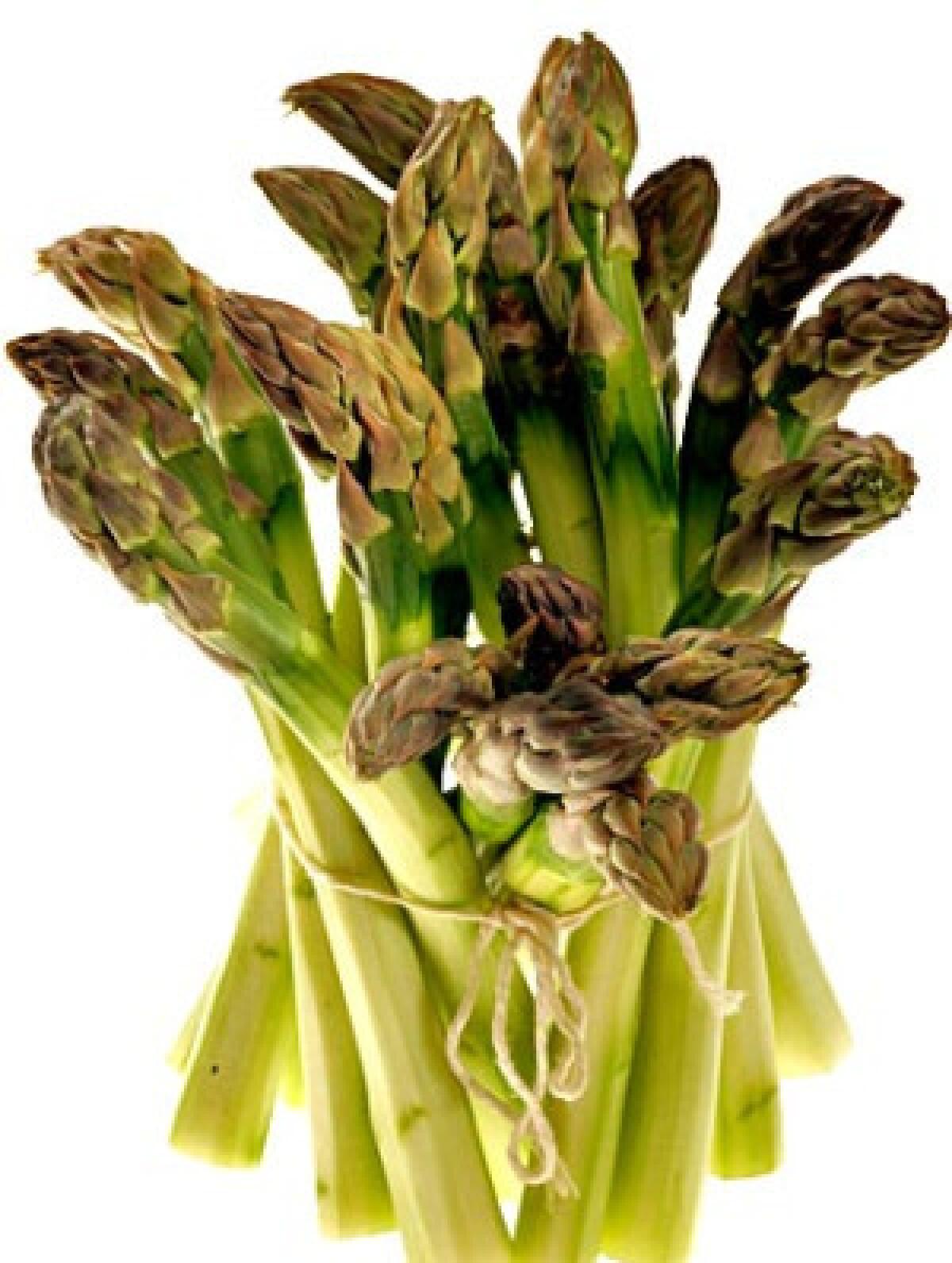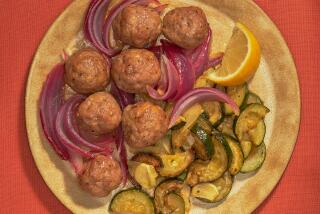Asparagus is a rite of spring

- Share via
I’m wary of people who dig too deep for food metaphors, particularly when they involve religion, but if ever there were a case for a perfect pairing of produce and season, it would be asparagus and Easter.
I love brightly colored eggs and bunny rabbits as much as the next guy. But if you want a concrete example of rebirth and the potential for new beginnings, just walk an asparagus field in early spring. What a few weeks before had been acres of brown raw dirt is now studded with hundreds of bright green asparagus spears poking through. In a month or so, the harvest finished, it will be a waist-high forest of ferns.
This is one metaphor that never fails to make me hungry. Over the last couple of weeks I’ve eaten asparagus for dinner at least three times. That may not seem like a lot, but when I say “eaten asparagus for dinner,” that’s just what I mean: My dinner was asparagus. OK, maybe some bread, too. And a glass of wine (though asparagus can be a tough match, Navarro Gewürztraminer is perfect).
The first night, I boiled it and dressed it with just a little very fruity olive oil, lemon juice and a generous sprinkling of crunchy sea salt. The next time, I steamed it and served it with a brown butter sauce and minced herbs. Then one night last week I repeated that dish but topped it with a softly fried egg — when you break the egg yolk, it flows out and combines with the brown butter to make a kind of deconstructed hollandaise. Be sure to serve any of these with plenty of buttered bread for sopping up the juices.
You get the picture.
This isn’t just any asparagus, of course. Though the dishes will work well with medium or even thin spears, to get the full effect (and to understand my insatiable hunger for them), you really need to try these with the jumbo asparagus from the farmers market purveyor Zuckerman’s. (All sizes of asparagus can come from the same set of roots — the biggest come from the very healthiest part, usually near the center.)
One of the old asparagus-growing families from the Stockton delta area, Zuckerman’s brings in these jumbos at the start of every season. Other places may have them from time to time, but Zuckerman’s is the most reliable source I’ve found. These spears are about as big around as my thumb, only five or six make a whole pound. Cooked to the point of perfect tenderness, they have a texture somewhere between meat and butter. They almost melt when you chew them, with only a slight fibrous crunch remaining.
Cooking takes only about seven or eight minutes, no matter whether you’re boiling or steaming them. To tell exactly when they’re done, poke a spear with a paring knife; it should slide in easily. Once that happens, lift a spear and it should be just soft enough to sag slightly.
Asparagus this thick does need to be peeled (really thin asparagus, which I use for pastas and risottos, doesn’t; medium asparagus can go either way).
You also need to cut away some of the base, which is dense and too chewy. Some cooks recommend holding the asparagus in two hands and snapping — they say it’ll break where the spear turns tender. But in my experience, it always breaks well past that point; you’ll wind up throwing away a pretty good bit of edible asparagus.
I’m greedy enough that that makes a difference. So I just cut off the very worst of the base — about 11/2 to 2 inches. To get rid of the last bit of toughness, peel the asparagus starting from the tip with a very light pressure and then gradually increase the pressure as you get to the base, where the toughest fibers are. Works every time.
There is something utterly compelling about this giant asparagus once it’s cooked. It’s not just the size, though that’s certainly impressive enough. The peeling method leaves a slightly crude appearance, and with the contrast of dark green tips and pale, glowing spears, the asparagus looks as if it’s been roughly carved from jade.
It’s gorgeous. When I served it the other night at dinner for a bunch of pretty tough-to-please eaters, everyone huddled around the platter with their iPhones out, snapping pictures.
Asparagus like this is a prime example of the principal rule of California cooking: When you have great ingredients, you don’t have to do much to make a great dish. I love this approach because, frankly, I’m no Thomas Keller. (“I know Thomas Keller; Thomas Keller is a friend of mine; and I, sir, am no Thomas Keller.”)
But this is the kind of elemental cooking that home cooks can excel at. The only thing even a great chef could do to make it better is add a flourish or two — not that there would be anything wrong with that, as witnessed by the-man-his-own-self’s version of asparagus with sauce mimosa from “Bouchon.” Basically, Keller takes a home cook’s classic (asparagus, vinaigrette, chopped hard-cooked eggs) and adds a central pool of very pretty asparagus coulis. Nice.
As delicious as this year’s asparagus has been, though, I’ve been eating it with a tinge of sadness. As my colleague David Karp reported on our website a couple of weeks ago, Zuckerman’s is threatening to pull its asparagus fields out of production because of pressure from cheaper imports.
It’s part of a larger trend that began at least a decade ago, and if you think complaining farmers are always just crying wolf, when I wrote about disappearing California asparagus in 2004, it was because the acreage had plummeted to only 24,000 (from roughly 40,000 in 2000).
Now those look like the good old days. Today, only about 11,500 acres remain, a little more than a quarter of what was there only 10 years ago.
Who knows whether Zuckerman’s will actually follow through with its threat (I seem to remember rumblings along the same lines in 2004)? What I’m absolutely sure of is that without my annual fix of jumbo asparagus, the spring holiday will seem awfully bleak.
And my dinners will take a lot more work.
Zuckerman’s sells at the following farmers markets: Studio City (Sunday), Long Beach (Friday and Sunday), Encino (Sunday), Hollywood (Sunday) and Santa Monica (Wednesday and Saturday organic).
More to Read
Eat your way across L.A.
Get our weekly Tasting Notes newsletter for reviews, news and more.
You may occasionally receive promotional content from the Los Angeles Times.









